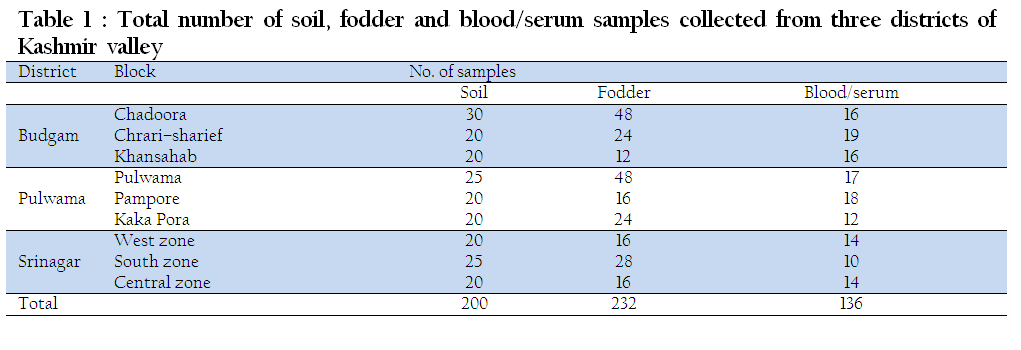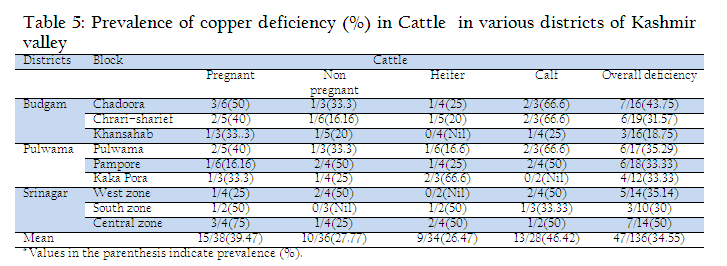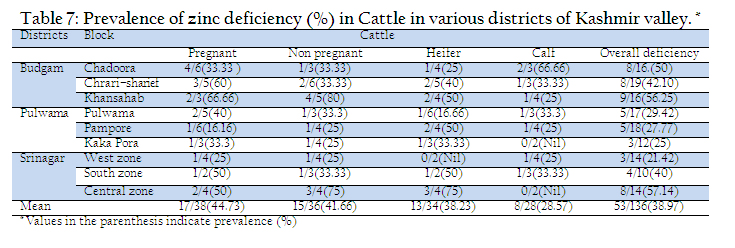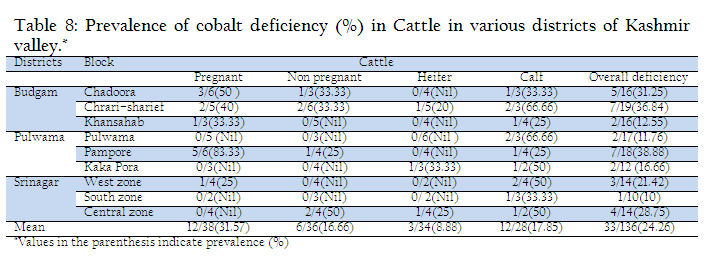Journal of Animal Health and Production
Research Article
Journal of Animal Health and Production 1 (3): 24 – 28Status of Micro Mineral Deficiency in Cattle in Kashmir Valley
Mohd. Iqbal Yatoo1*, Umesh Dimri1, Mahesh Chandra Sharma2
- Division of Medicine, IVRI, Izatnagar, Barielly, U.P.–243122
- ICAR, HQ New Delhi–110114
*Corresponding author: iqbalyatoo@gmail.com
ARTICLE CITATION:
Yatoo MI, Dimri U, Sharma MC (2013). Status of micro mineral deficiency in cattle in kashmir valley. J Anim. Health Prod. 1 (3): 24 – 28.
Received: 2013–03–26, Revised: 2013–07–21, Accepted: 2013–07–23
The electronic version of this article is the complete one and can be found online at
(http://nexusacademicpublishers.com/table_contents_detail/11/61/html)
which permits unrestricted use, distribution, and reproduction in any medium, provided the original work is properly cited
Abstract
The main objective of the present study was to evaluate the prevalence of micro mineral deficiency in soil, fodder and cattle of Kashmir valley. For this purpose 200 soil samples, 232 fodder samples and 136 serum samples from cattle were collected from three districts of Kashmir valley viz. Budgam, Pulwama and Srinagar. Micro mineral estimation was done by atomic absorption spectrophotometry in Clinical Medicine Laboratory at IVRI. Overall prevalence of copper, iron, zinc and cobalt deficiency in soil was 23.50%, 14.50%, 38.00% and 24.00% respectively. Mean prevalence of copper, iron, zinc and cobalt deficiency in fodder was 24.13%, 17.67%, 34.05% and 24.13% respectively. Mean prevalence of copper, iron, zinc and cobalt deficiency in cattle was 34.55%, 16.17%, 38.97% and 24.26% respectively. Among cattle, calves showed higher copper (46.42%) deficiency whereas pregnant cattle showed higher zinc (44.73%) and cobalt (31.57%) deficiency. Iron deficiency was lower in all groups (16.17%). From this study it can be concluded that the cattle of Kashmir valley are predisposed to mineral deficiency. Hence supplementation of cattle with mineral supplements is imperative under prevailing feeding systems.
INTRODUCTION
Livestock health and production are dependent on the quality and quantity of nutrients present in the feed and fodder and the soil in which these fodders are grown. A deficiency or imbalance in either may render animal inefficient both in health and production. Mineral disorders severely inhibit grazing livestock health and production in developing tropical countries and are often of significant consequences than are the infectious diseases (Mc Dowell, 1985). Micro mineral imbalances and deficiencies have been increasingly implicated in heatlh problems of dairy animals (Sharma et al., 2003). Mineral deficiency is an area specific problem (McDowell, 1985). In our country micro mineral deficiency status has been evaluated in different states (Sharma et al., 2003 and 2006, Kumar et al., 2004) but such study is lacking in Kashmir valley.
MATERIALS AND METHODS
Three blocks from each of the three districts of Kashmir valley viz. Budgam (Chadoora, Chrari–Sharief, Khansahab), Pulwama (Pulwama, Pampore, Kaka Pora) and Srinagar (west, south and central zone), were selected. Soil samples (n=200) were collected with the help of auger, up to 15 cm depth. Collected soil samples were dried for overnight in hot air oven at temperature 100±5°C. The samples were ground and stored in airtight polythene packets to analyze mineral content. Various fodder samples (n=232) that were being fed to animals were collected and fodder sample were collected from the same field where soil samples were taken. These included paddy straw, wheat straw, rice bran, wheat bran and mustard oil cake,. Collected fodder samples were dried in a hot air oven at temperature 100±5°C overnight ground and stored in airtight polythene packets for laboratory analysis. During the survey blood samples (n=136) were collected from cattle (Table 1). The detail of blood samples distribution has been given in Table 2.

Table 1: Total number of soil, fodder and blood/serum samples collected from three districts of Kashmir valley.
From jugular vein about 10 ml blood was collected by Teflon needle in a sterilized test tube without any anticoagulant. Tubes containing blood were kept at room temperature (20°–22°C). Clot appeared within 2 h and that was broken with the help of pasteur pipette within one hour. Serum was collected with the help of a micropipette. Centrifugation of serum was performed and it was stored in refrigerator at–4°C in labeled glass vials. Soil samples were digested as per Franeck (1992). The fodder samples were digested as per Trolson (1969). Serum samples were digested as per procedure described by Kolmer et al. (1951). While digestion of the soil, fodder and serum samples, simultaneous digestions of reagent blanks were also undertaken and the final volume was similarly made to 10 ml to have blank. For the estimation of minerals in the samples atomic absorption spectrophotometer (AAS) was used. Mineral sample concentration was expressed in ppm and minimum 3 standards of known concentration were used for calibration after that unknown samples were analyzed. The percent prevalence was calculated using reported critical values of corresponding minerals in soils, fodder and animal (cattle).
RESULTS AND DISCUSSION
Overall prevalence of copper, iron, zinc and cobalt deficiency in soil was 23.50%, 14.50%, 38.00% and 24.00% respectively (Table 3). Sharma et al. (2003) reported a prevalence deficiency of 55.26%, 6.9%, 59.12% and 7.89% of Cu, Co, Zn and Fe respectively, in soil. Lowest prevalence of copper deficiency was observed in Chari–sharief and west zone of Srinagar (15% in each) and the highest in Pulwama and south zone of Srinagar (28% in each). Prevalence of iron deficiency is highest in Khansahab (20%) and west zone (20%) of Srinagar and lowest in Pulwama (8%). Singh (1998) reported that 51.2% soil samples were deficient in zinc in north India. Prevalence of zinc deficiency is highest in Chari–Sharief and Kaka Pora (45% each) and lowest in central zone of Srinagar (30%). Ahmed et al. (2005) and Kirmani et al. (2006) reported that the soils under rice cultivation in Srinagar and Anantnag district have low to marginally low Zn content. The prevalence of cobalt deficiency was observed highest in west and central zone of Srinagar (30%) and lowest in south zone of Srinagar (16%). Sarkar et al. (1990) and Kumar et al. (2004) have also reported similar results.
Mean prevalence of copper, iron, zinc and cobalt deficiency in fodder was 24.13%, 17.67%, 34.05% and 24.13% respectively (Table 4). These findings are in corroboration with Sharma et al. (2003) who reported prevalence deficiency of 60.64%, 6.7%, 61.22% and 11.37% of Cu, Co, Zn and Fe respectively, in fodder. The prevalence of copper deficiency was recorded highest in Chadoora and south zone of Srinagar (29% each) and lowest in Khansahab (17%). The highest prevalence was observed in Khansahab (41%) and lowest in Pulwama (8%). Prevalence of zinc deficiency in fodder was highest in central zone (44%) and lowest in west zone of Srinagar (13%). Ahmed et al, (2005) reported zinc deficiency but adequate copper, iron and manganese in fodders in Anantnag district of Kashmir valley. The average value of cobalt deficiency in fodder of Kashmir valley was observed to be 24.13%. The highest was observed in west zone (31%) and lowest in south zone (18%) of Srinagar. Tiwari et al. (2007) and Kumaresen et al. (2010) have also reported mineral deficiency in fodder in hilly areas.
Mean prevalence of copper, iron, zinc and cobalt deficiency in cattle was 34.55%, 16.17%, 38.97% and 24.26% respectively. Similar findings were made by Das et al. (2009) and Kumar et al. (2008). Highest overall prevalence of copper deficiency in cattle was observed in Chadoora (43.75%) and lowest in Khansahab (18.75%). Highest prevalence was observed pregnant cattle of central zone of Srinagar (75%) and lowest in Pampore (16.16%). Sharma et al. (2009) have reported similar results. Highest prevalence was observed in non–pregnant cattle of Pampore and west zone of Srinagar, 50% each and lowest in that of Chrari–sharief (16.66%). Heifers in Kaka Pora showed highest prevalence (66.6%) while those in Pulwama showed lowest prevalence of 16.6%. Chadoora, Chrari–sharief and Pulwama recorded a prevalence of 66.66% each in calves where as Pampore, west zone and central zone recorded a prevalence of 50%. Khansahab recorded lowest 25% and south zone of Srinagar recorded 33.33% prevalence (Table 5)
Highest overall prevalence of iron deficiency in cattle was observed in south zone of Srinagar (30%) and lowest in Kaka Pora (8.33%). Similar results were noted by Sharma et al. (2009). Highest prevalence was observed in pregnant cattle of South–zone (50%) and lowest in Chadoora and Pampore (16.6% each). Chadoora, south zone of Srinagar and Pulwama recorded a prevalence of 33.33% each in non–pregnant cattle where as Chrari–sharief and west zone of Srinagar recorded a prevalence of 25% and 16.66% respectively (Table 6). Highest prevalence was observed in heifers of central and south zone of Srinagar (50% each) and lowest in Pulwama 16.66%. Calves of central zone of Srinagar recorded a prevalence of 50% while those in Pulwama recorded 33.3%. In Khansahab, Pampore and west zone of Srinagar prevalence recorded was 25%. Das et al. (2009) and Kumar et al. (2008) have also reported iron deficiency in cattle.
Highest overall prevalence of zinc deficiency in cattle was observed in south zone of Srinagar (57.14) and lowest in west zone of Srinagar (21.42%). Sharma et al (2009) have also reported higher zinc deficiency in cattle. Highest prevalence was observed pregnant cattle of Khansahab (66.6%) and lowest in Pampore (16.16%). In Khansahab highest prevalence (80%) was observed in non–pregnant cattle where as west zone of Srinagar, Kaka Pora and Pampore recorded a prevalence of 25% each (Table 7). Heifers of Central zone of Srinagar recorded a highest prevalence of 75% while those in Pulwama recorded a lowest of 16.66%. Highest prevalence was observed in calves of Chadoora (66.66%) where as in Pampore, Khansahab and west zone of Srinagar recorded 25% each. Similar findings were made by Das et al. (2009) and Kumar et al. (2008).
Highest overall prevalence of cobalt deficiency in cattle was observed in Pampore (38.88%) and lowest in south zone of Srinagar (10%). Similar reports were made by Kumaresan et al. (2010). Pregnant cattle of Pampore recorded highest prevalence (83.33%) while that of west zone of Srinagar was lowest (25%). Central zone of Srinagar recorded highest prevalence (50%) in non–pregnant cattle where as Pampore recorded lowest (25%). Chari–Sharief, Central zone of Srinagar and Kaka Pora recorded a prevalence of 20% 33.33% and 25% respectively in heifers (Table 8). In district Budgam, Chari–Sharief (66.66%), recorded highest followed by Chadoora (33.33%) and Khansahab (25%) in calves. These findings are in corroboration of the findings of Das et al. (2009) and Kumar et al. (2008).
Thus, in the present study higher prevalence of zinc, copper and cobalt deficiency may be attributed to deficiency of micro minerals in fodder samples which were severely deficient in zinc, marginally deficient in copper and cobalt while iron content was adequate to high. This in turn may be attributed to deficient status of zinc, copper and cobalt in soil of the region as mineral content in plants depends on soil type, plant species, and stage of maturity, pasture management and agro–climatic conditions (Mc Dowell, 1985, Underwood and Suttle, 2001). Besides higher prevalence deficiency of copper (46.42%) in calves and zinc (44.73%) and cobalt (31.57%) in pregnant cattle may be due to the variation of micro mineral requirement in different groups of cattle (Spears, 2011). Similar findings were made by Sharma et al. (2004, 2006) and Khan et al. (2007). Iron deficiency was lower in all groups which may be due to the availability of adequate amount of iron in the soil and fodder (Yatoo et al., 2011).
CONCLUSION
Based on the present findings it can be concluded that the cattle of Kashmir valley are predisposed to micro mineral deficiency under the prevailing feeding system. Hence supplementation of cattle with mineral supplements is imperative.
ACKNOWLEDGEMENT
Authors are thankful to the Director, IVRI for providing all the necessary requirements for this research. Thanks are also due to staff of the Clinical Medicine Laboratory, Division of Medicine, IVRI.
REFERENCES
Ahmed Z, Ali T, Shahid A and Kirmani N A (2005). Correlation studies on micronutrients cations with soil properties of apple orchard of Kashmir. Indian J. Horticult. 62(4): 391-93.
Das G, Sharma MC, Joshi C and Rupasi T (2009). Status of soil, fodder and serum (cattle) mineral in high rainfall area of NE region. Ind. J. Anim. Sci. 79(3): 306-310.
Franeck MA (1992). Soil lead value in small town environment. A case study from Mt. Pleasant Michigam. Environmental Pollution. 76: 251–57.
http://dx.doi.org/10.1016/0269-7491(92)90144-Y
Khan ZI, Ahmad MAK, Mustafa I and Danish M (2007). Evaluation of micro minerals composition of different grasses in relation to livestock requirements. Pak. J. Bot. 39(3): 719-728.
Kirmani NA, Ali T, Ahmad J and Wani M A (2006). Effect of different levels of zinc and phosphrous on dry matter, N, K and S uptake of rice in Alluvial soils of Kashmir. SKUAST-J, Res. 8: 53-57.
Kolmer JA, Spanbling EH and Robinson HW (1951). Approved Laboratory Techniques. Appleton Century Crafts New York.
Kumar P. Sharma MC, Joshi C, Saxena N and Dwivedi P (2004). Prevalence of micro-mineral deficiencies in soil fodder and cattle of Lucknow region and status of vitamin and reproductive steroids. Ind. J. Vet. Path. 28(1): 47-50.
Kumar R, Sharma KB, Sharma M and Sharma R (2008). Mineral status of livestock of Shivalik hill zone of Himachal Pradesh. Ani. Nutr. Feed Tech. 8: 253-257.
Mc Dowell LR (1985). Nutrition of Grazing Ruminants in Warm Climates. Academic Press. Orlando Florida.
Kumaresan A, Bujarbaruah KM, Pathak KA, Brajendra and Ramesh T (2010). Soil–plant–animal continuum in relation to macro and micro mineral status of dairy cattle in subtropical hill agro ecosystem. Trop Anim Health Prod. 42:569–577
http://dx.doi.org/10.1007/s11250-009-9459-8
PMid:19774479
Sarkar S, Mishra SK. and Das SK (1990). Soil-plant-animal relationship in respect of micro-nutrient in anaemic black bengal goats. Indian J. Anim. Hlth. 23: 59-64.
Sharma MC and Joshi C (2004). Soil fodder and serum micro mineral status and haematobiochemical profile in cattle of Garhwal region of Uttaranchal state. Ind. J. Anim. Sci., 74: 775-779.
Sharma MC, Joshi C and Das G (2009). Soil, fodder and serum mineral (cattle) and haematobiochemical profile in some districts of Central Uttar Pradesh. Indian Journal of Animal Sciences. 79 (4): 411–415.
Sharma MC, Kumar P, Joshi C and Kaur H (2006). Status of Serum Minerals and Biochemical Parameters in Cattle of Organized Farms and Unorganised Farms of Western Uttar Pradesh. Asian J. Ani. Vet. Adv. 1: 33-41.
http://dx.doi.org/10.3923/ajava.2006.33.41
Sharma MC, Raju S, Joshi C, Kaur H and Varshney VP (2003). Studies on Serum Micro-mineral, hormone and vitamin profile and its effect on production and therapeutic management of buffaloes in Haryana state of India. Asian-Aust. J. Anim. Sci. 16(4): 519-528.
Singh MV (1998). Decade of research. Bhopal: Indian Institute of Soil Science. In: Gupta U. C. Wu K. and Liang S. (2008). Micronutrients in Soils, Crops, and Livestock. Earth Science Frontiers, 15 (5): 110-125.
Spears JW (2011). Role of Mineral and Vitamin Status on Health of Cows and Calves. WCDS Advances in Dairy Technology. 23: 287-297.
Tiwary MK, Tiwari DP, Mondal BC and Kumar A (2007). Macro and micro mineral profile in soil, feeds and animals in Haridwar district of Uttarakhand. Ani. Nutr. Feed Tech. 7: 187-195.
Trolson JE (1969). Outline for in vitro Digestion of Forage Samples. Research station swift current, Saska Chawn, Canada.
Underwood EJ and Suttle NF (2001). The mineral nutrition of livestock (4th Edition). CABI Publishing, CAB International, Wallingford, U. K.
Yatoo M I, Devi S, Kumar P, Tiwari R and Sharma MC (2011). Soil plant animal micro mineral status and their inter relation in Kashmir valley. Ind. J. Ani. Sci. 81(6): 628-630.











